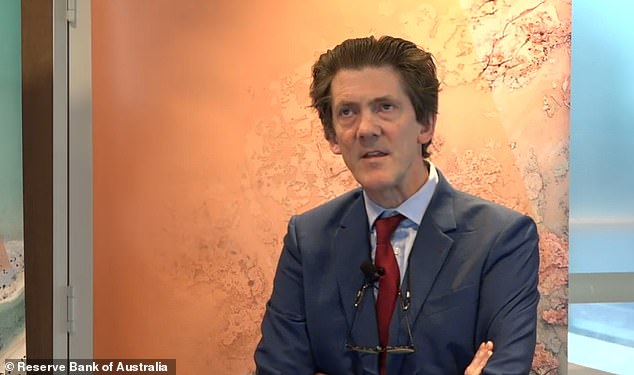- RBA deputy governor says inflation data ‘very welcome’
A senior Reserve Bank official has given a strong hint interest rates will be cut next month.
Andrew Hauser, the RBA’s deputy governor, said the underlying inflation rate of 2.7 per cent for the June quarter was a number closer to the mid-point of the Reserve Bank’s two to three per cent target.
‘The data yesterday were very welcome, I could stop there,’ he said.
‘We were looking for more evidence that inflation was moving sustainably back to the mid-point and we’ve had another piece of that jigsaw yesterday.’
The Reserve Bank on July 8 surprised financial markets by leaving the cash rate on hold at 3.85 per cent.
At the time, Governor Michele Bullock said the March quarter’s underlying inflation rate of 2.9 per cent was still too high, despite being within the RBA band.
But new Australian Bureau of Statistics inflation data, released on Wednesday, showed underlying inflation falling to the lowest level since December 2021, during the aftermath of Covid lockdowns in Sydney and Melbourne.
This trimmed mean measure is the RBA’s preferred inflation yardstick because it removes volatile price movements like electricity rebates and petrol prices.

Andrew Hauser, the RBA’s deputy governor, has given a strong hint interest rates will be cut next month.
Headline or consumer price index inflation fell again to just 2.1 per cent, the lowest since March 2021.
Both numbers have firmed up the prospect of a rate cut on August 12, that would see the cash rate fall back to 3.6 per cent for the first time since May 2023 and cut monthly repayments by $100 on an average, $660,000 mortgage.
Treasurer Jim Chalmers bragged that inflation was falling in Australia but rising elsewhere.
‘Inflation is rising in the US, the UK, Canada and New Zealand, and it’s falling in Australia,’ he told Nine’s Today Show on Thursday morning.
‘Secondly, food inflation slowed in those numbers yesterday. I understand that people are still under pressure when they’re at the supermarket.’
Fruit and vegetable prices rose by 4.9 per cent over the year, separate monthly inflation data showed.
This data also showed an 8 per cent annual drop in petrol prices and a 6.3 per cent decline in electricity bills, with the federal government’s $75 quarterly rebates continuing until the end of 2025.
But overall services inflation in the quarterly data, at 3.3 per cent, was still an issue with education costs rising by 5.5 per cent, health costs rose by 4.1 per cent, and insurance and financial services up by 3.1 per cent.

New Australian Bureau of Statistics inflation data, released on Wednesday, showed underlying inflation falling to the lowest level since December 2021, during the aftermath of Covid lockdowns in Sydney and Melbourne (pictured is Sydney’s Pitt Street Mall)
Unemployment is still low at 4.3 per cent but the level for June was at the highest point since November 2021.
Mr Hauser, a former Bank of England official, said the jobless rate could rise higher than forecast and lead to even deeper rate cuts.
‘We could easily get a surprise by unemployment or any other macroeconomic variables on either side,’ he said.
‘If unemployment did rise sharply, we’d have to react.’
The futures market sees the RBA cutting interest rates three more times by the end of 2025, that would take the cash rate back to 3.1 per cent for the first time since February 2023.






